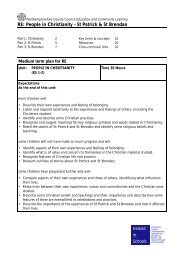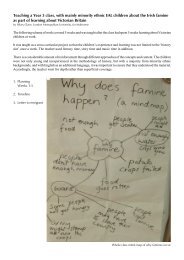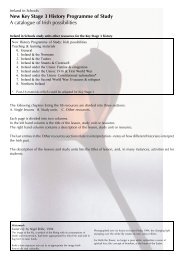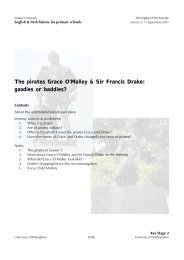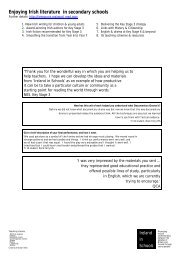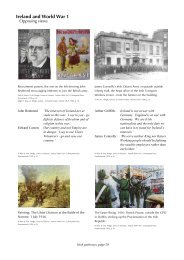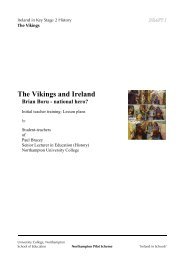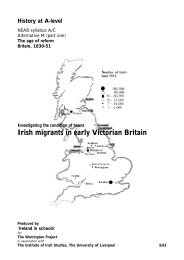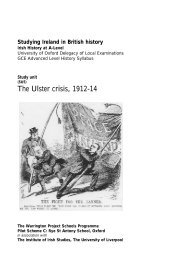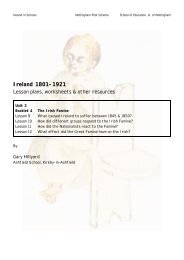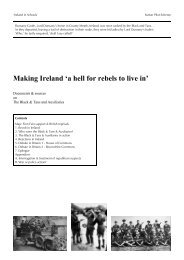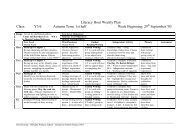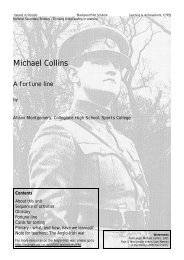E:\Irish music\A4 Irish history in song 1 & 2.wpd - Ireland in Schools
E:\Irish music\A4 Irish history in song 1 & 2.wpd - Ireland in Schools
E:\Irish music\A4 Irish history in song 1 & 2.wpd - Ireland in Schools
You also want an ePaper? Increase the reach of your titles
YUMPU automatically turns print PDFs into web optimized ePapers that Google loves.
Easter Ris<strong>in</strong>gPeadar Kearney and another popular ballad writer, Brian O’Higg<strong>in</strong>s (Brian na Banban), cont<strong>in</strong>ued to usethe cutt<strong>in</strong>g edge of sarcasm to great effect. They used some of their <strong>song</strong>s to mock the police who at thattime were encouraged to learn the <strong>Irish</strong> language so that they might be able to charge the rebels withmak<strong>in</strong>g seditious speeches. However, when it came to writ<strong>in</strong>g about the ‘Easter Ris<strong>in</strong>g,’ Peadar Kearneywrote not about a ‘glorious rebellion’ but <strong>in</strong> an understated, sarcastic Dubl<strong>in</strong> fashion, referred to theRis<strong>in</strong>g as a row <strong>in</strong> the town.The Row <strong>in</strong> the TownI’ll s<strong>in</strong>g you a <strong>song</strong> of a row <strong>in</strong> the town,When the green flag went up and the crown rag came down,‘Twas the neatest and sweetest th<strong>in</strong>g ever you saw,And they played the best game played <strong>in</strong> Er<strong>in</strong> go Bragh.God rest gallant Pearse and his comrades who died,Tom Clarke, MacDonagh, MacDermott, McBride,And here’s to Jim Connolly he gave one hurrah,And he placed the mach<strong>in</strong>e guns for Er<strong>in</strong> go Bragh.Big moments <strong>in</strong> <strong>history</strong> like the 1916 Rebellion do not always provide <strong>in</strong>spiration for a great ballad.Patrick Pearse, the iconic leader of 1916 is not celebrated <strong>in</strong> the popular <strong>song</strong> tradition, yet the labourleader James Connolly is. Why is there a ballad for Connolly but none for Pearse? Perhaps the mannerof Connolly’s execution - still suffer<strong>in</strong>g from his wounds he was shot sitt<strong>in</strong>g <strong>in</strong> a chair - or perhaps his roleas a trade union leader <strong>in</strong>spired the ballad maker to immortalise him <strong>in</strong> <strong>song</strong>.James ConnollyWhere oh where is our James Connolly,Where oh where can that brave man be,He has gone to organise the Union,That work<strong>in</strong>g men might yet be free.Where oh where is the citizen army,Where oh where can that brave band be,They have gone to jo<strong>in</strong> the great rebellion,And break the bonds of slavery.The <strong>in</strong>spiration for a ballad is many and varied. Sometimes it can be a great tragedy, an ambush, amurder or just a simple phrase that sets a chord vibrat<strong>in</strong>g. A parish priest from Kilcoo <strong>in</strong> Co. Down,Canon Charles O’Neill, attended the first sitt<strong>in</strong>g of the new Dáil, or parliament, <strong>in</strong> Dubl<strong>in</strong> <strong>in</strong> 1919. Asthe names of the elected members were called out he was moved by the number of times the names wereanswered by ‘faoi ghlas ag na Gaill’ (locked up by the foreigner). On return<strong>in</strong>g home he wrote one of thef<strong>in</strong>est <strong>song</strong>s that recounts the story of the 1916 Rebellion.The Foggy DewAs down the glen one Easter mornThrough a city fair rode I.There armed l<strong>in</strong>es of march<strong>in</strong>g men,In squadrons did pass me by.No pipe did hum, no battle drum,Did sound out its loud tattoo.But the angelus bell o’er the Liffey’s swell,Rang out through the foggy dew.Right proudly high over Dubl<strong>in</strong> townThey flung out the flag of war.‘Twas far better to die ‘neath an <strong>Irish</strong> sky,Than at Suvla or Sud el Bar.And from the pla<strong>in</strong>s of royal Meath,Brave men came hurry<strong>in</strong>g through,While Britannia’s Huns with their long-range guns,Sailed <strong>in</strong>to the foggy dew.War of <strong>in</strong>dependencePerhaps the best known and most widely sung of all the <strong>song</strong>s of <strong>Irish</strong> resistance is the one whichcommemorates the execution of Kev<strong>in</strong> Barry <strong>in</strong> Dubl<strong>in</strong>’s Mountjoy Jail on 1st November 1920. Barrywas an 18 year-old medical student who jo<strong>in</strong>ed the <strong>Irish</strong> Volunteers and was sentenced to death byhang<strong>in</strong>g after he was convicted of the kill<strong>in</strong>g of a British soldier.The execution received <strong>in</strong>ternational attention and many appeals for a reprieve were turned down. The<strong>song</strong> was written by an anonymous exile <strong>in</strong> Glasgow and later was heard by a worldwide audience whenthe great American s<strong>in</strong>ger Paul Robeson recorded it.Kev<strong>in</strong> BarryIn Mountjoy Jail one Monday morn<strong>in</strong>g,High upon the gallows tree,Kev<strong>in</strong> Barry gave his young lifeFor the cause of liberty.Just a lad of eighteen summers,Yet no one can deny,As he walked to death that morn<strong>in</strong>gHe proudly held his head on high.Just before he faced the hangman,In his dreary prison cell,British soldiers tortured BarryJust because he would not tellThe names of his brave comrades,And other th<strong>in</strong>gs they wished to know,‘Turn <strong>in</strong>former or we’ll kill you!’Kev<strong>in</strong> Barry answered ‘No!’IiS, <strong>Irish</strong> <strong>history</strong> <strong>in</strong> <strong>song</strong> 1 & 2, page 20



